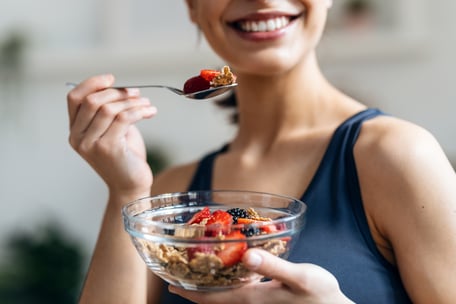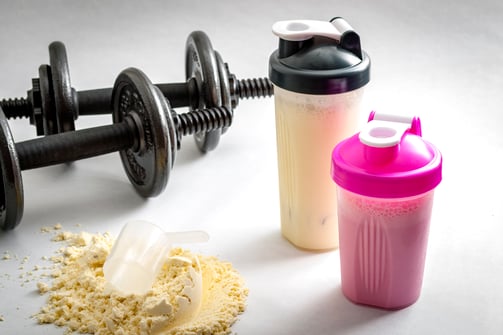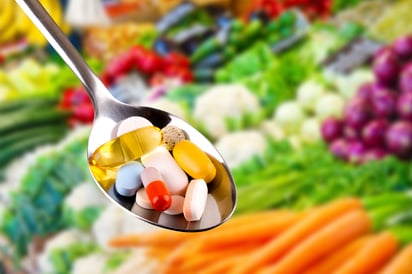 As athletes, we understand the importance of fueling our bodies properly to perform at our best. Whether you're hitting the gym regularly, training for a marathon, or simply aiming to lead a healthy lifestyle, how you balance your plate can significantly impact your energy levels, recovery, and overall well-being. That's why I'm introducing the concept of "Performance Plates" – a simple yet effective way to structure your meals based on your activity level and goals.
As athletes, we understand the importance of fueling our bodies properly to perform at our best. Whether you're hitting the gym regularly, training for a marathon, or simply aiming to lead a healthy lifestyle, how you balance your plate can significantly impact your energy levels, recovery, and overall well-being. That's why I'm introducing the concept of "Performance Plates" – a simple yet effective way to structure your meals based on your activity level and goals.
Let's break down the essential components of the Performance Plates for athletes first.
- Protein: Vital for muscle repair and growth, protein supports recovery, and enhances
strength, and reduces the risk of injury. - Color (Fruits and Vegetables): Packed with vitamins, minerals, and antioxidants, colorful
fruits and vegetables aid in reducing inflammation, supporting immune function, and
promoting overall health. - Carbohydrates: Serving as the body's primary fuel source, carbohydrates are crucial for
replenishing glycogen stores, sustaining energy levels, and optimizing performance,
particularly during high-intensity exercise and endurance activities.
The First Plate: Low-Intensity Training and Rest Day Plate
Imagine your plate divided into halves and quarters. Half of your plate should be filled with
colorful fruits and vegetables. The remaining quarters are dedicated to protein and
carbohydrates, with an emphasis on lean protein sources and whole grains. This plate is perfect
for rest days, light bodyweight training, or when aiming for weight loss.
The Second Plate: Moderate Intensity Training Plate
For days when your workouts are a bit more intense – think moderate cardio sessions, strength
training, or longer runs – your plate shifts slightly. Divided into thirds, you'll still prioritize colorful
fruits and veggies, but now you'll increase your portions of protein and carbohydrates. This
balanced approach ensures sustained energy levels and supports muscle recovery and growth.
The Third Plate: Hard Intensity Training Plate
When your training demands peak performance – whether it's two-a-day practices,
high-intensity interval training, or pushing your limits in the weight room – your plate should
reflect this intensity. Half of your plate is now dedicated to carbohydrates to fuel your workouts
and support recovery, while protein and colorful fruits and vegetables make up the remaining
quarters.
By aligning your nutrition with your activity level and goals, you can optimize your performance,
enhance recovery and support long-term health. Whether you're striving for weight loss,
maintenance, or muscle gain, the principles of balanced Performance Plates can guide you
toward success.
Looking to better understand "your plate"? Download our Performance Plate handout to visually understand your nutrition needs based on your workout.
This blog was written by Michael Horner, an Aligned Health Practice Registered Dietitian.


 For athletes and gym enthusiasts, performance and recovery are top priorities. While protein often takes center stage in their nutrition plans, there's an unsung hero that deserves more spotlight: dietary fiber. This essential nutrient, found in fruits, vegetables, whole grains, and legumes, plays a crucial role in maintaining not just overall health, but also enhancing athletic performance and recovery.
For athletes and gym enthusiasts, performance and recovery are top priorities. While protein often takes center stage in their nutrition plans, there's an unsung hero that deserves more spotlight: dietary fiber. This essential nutrient, found in fruits, vegetables, whole grains, and legumes, plays a crucial role in maintaining not just overall health, but also enhancing athletic performance and recovery.
 Thousands of sports nutrition supplements are touted to improve strength, endurance, and a variety of other athletic factors. But do they work and are they necessary? Below are some of the most common supplements advertised for athletes, as well as what they do, how well they work, and how much is safe to supplement. It’s important to note that you should always consult your physician or a registered dietitian specializing in sports medicine before starting any new supplement.
Thousands of sports nutrition supplements are touted to improve strength, endurance, and a variety of other athletic factors. But do they work and are they necessary? Below are some of the most common supplements advertised for athletes, as well as what they do, how well they work, and how much is safe to supplement. It’s important to note that you should always consult your physician or a registered dietitian specializing in sports medicine before starting any new supplement. Sodium, potassium, magnesium, calcium, phosphate, and chloride are all electrolytes, or minerals that fulfill essential roles within the body. More specifically, sodium, chloride, and potassium work together to maintain fluid balance within the body, while magnesium and calcium promote optimal muscle function and aid in energy metabolism.
Sodium, potassium, magnesium, calcium, phosphate, and chloride are all electrolytes, or minerals that fulfill essential roles within the body. More specifically, sodium, chloride, and potassium work together to maintain fluid balance within the body, while magnesium and calcium promote optimal muscle function and aid in energy metabolism.  Dietary supplement usage is reaching an all-time high. The
Dietary supplement usage is reaching an all-time high. The 
 Every couple of years, the world’s best athletes get to compete in either the winter or summer Olympics, and I have been wondering about what they eat! I know as a dietitian I am obsessed with food, but surely other people wonder about sports nutrition on this kind of scale, too. These elite athletes have a routine when it comes to their nutrition, especially before competition. Then they are put into a situation where they have a giant smorgasbord of choices in the Olympic Village. How hard it must be to try to stick to their plan…at least until their event is over.
Every couple of years, the world’s best athletes get to compete in either the winter or summer Olympics, and I have been wondering about what they eat! I know as a dietitian I am obsessed with food, but surely other people wonder about sports nutrition on this kind of scale, too. These elite athletes have a routine when it comes to their nutrition, especially before competition. Then they are put into a situation where they have a giant smorgasbord of choices in the Olympic Village. How hard it must be to try to stick to their plan…at least until their event is over.